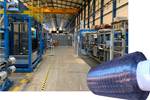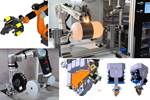MTorres launches BMI AFP head for F-35 program at SABCA
High-angle AFP head featuring MTorres’ latest upgrades advances fabrication of wing skins and covers for the F-35.
Throught its latest high-angle AFP head, MTorres increased the clearance angles for layup of BMI parts. Source | MTorres
MTorres (Torres de Elorz, Spain), automation provider of industrial processes, has developed a novel fiber placement head capable of laying bismaleimide (BMI) resin used in military programs such as the Lockheed Martin F-35. The head will be part of a TorresFiberLayup system, to be installed at aerospace company SABCA’s (Belgium) Limburg facility, where SABCA will be responsible for the fabrication of wing skins and covers for the F-35.
The 2024 machine design incorporates all of the latest MTorres developments resulting from the previous 75 automatic fiber placement (AFP) machines the company has delivered worldwide — this includes patented rotary servo-driven cutting, and high angle clearance needed for F-35 skins and covers, as well as exchangeable AFP quick connectors to enable end effector exchange in less than two minutes. Future upgrades will incorporate on-line inspection devices and other material layup capabilities.
MTorres AFP machines have been widely used in larger and less geometrically complex parts (e.g., Airbus A350 and Boeing 787 wings). For F-35 wing skins, the goal is to dramatically increase the layup performance using BMI, meeting 2024 overall equipment efficiency standards while bringing state-of-the-art capabilities to SABCA.
Related Content
-
Industrializing additive manufacturing in the defense/aerospace sector
GA-ASI demonstrates a path forward for the use of additive technologies for composite tooling, flight-qualified parts.
-
Plant tour: Renegade Materials Corp., Miamisburg, Ohio, U.S.
Renegade Materials is known for high-performance prepregs for aerospace applications. Following its acquisition by Teijin in 2019, the company has expanded capacity and R&D efforts on a range of aerospace-targeted materials.
-
LifePort acquires Aeromatrix Composites advanced materials line
The aircraft manufacturer solidifies its capability to provide next-generation advanced materials solutions to aerospace and defense customers.












.jpg;maxWidth=300;quality=90)

